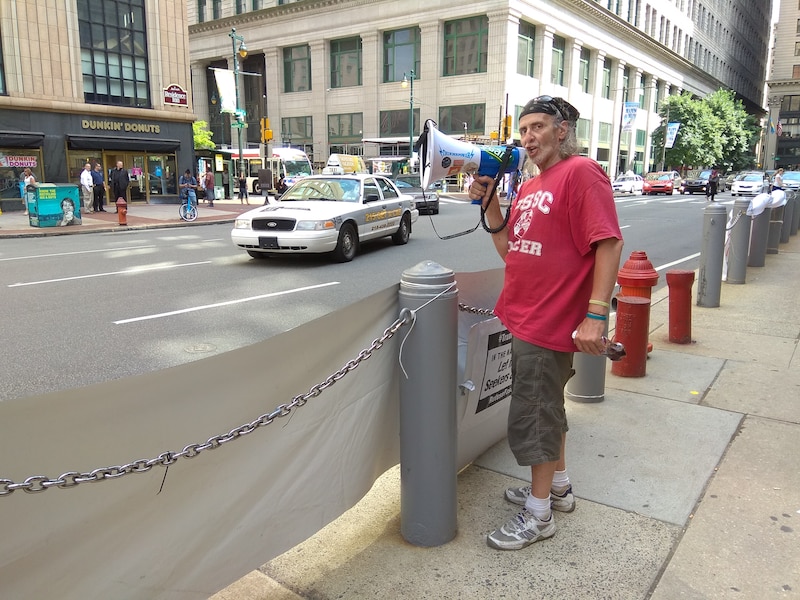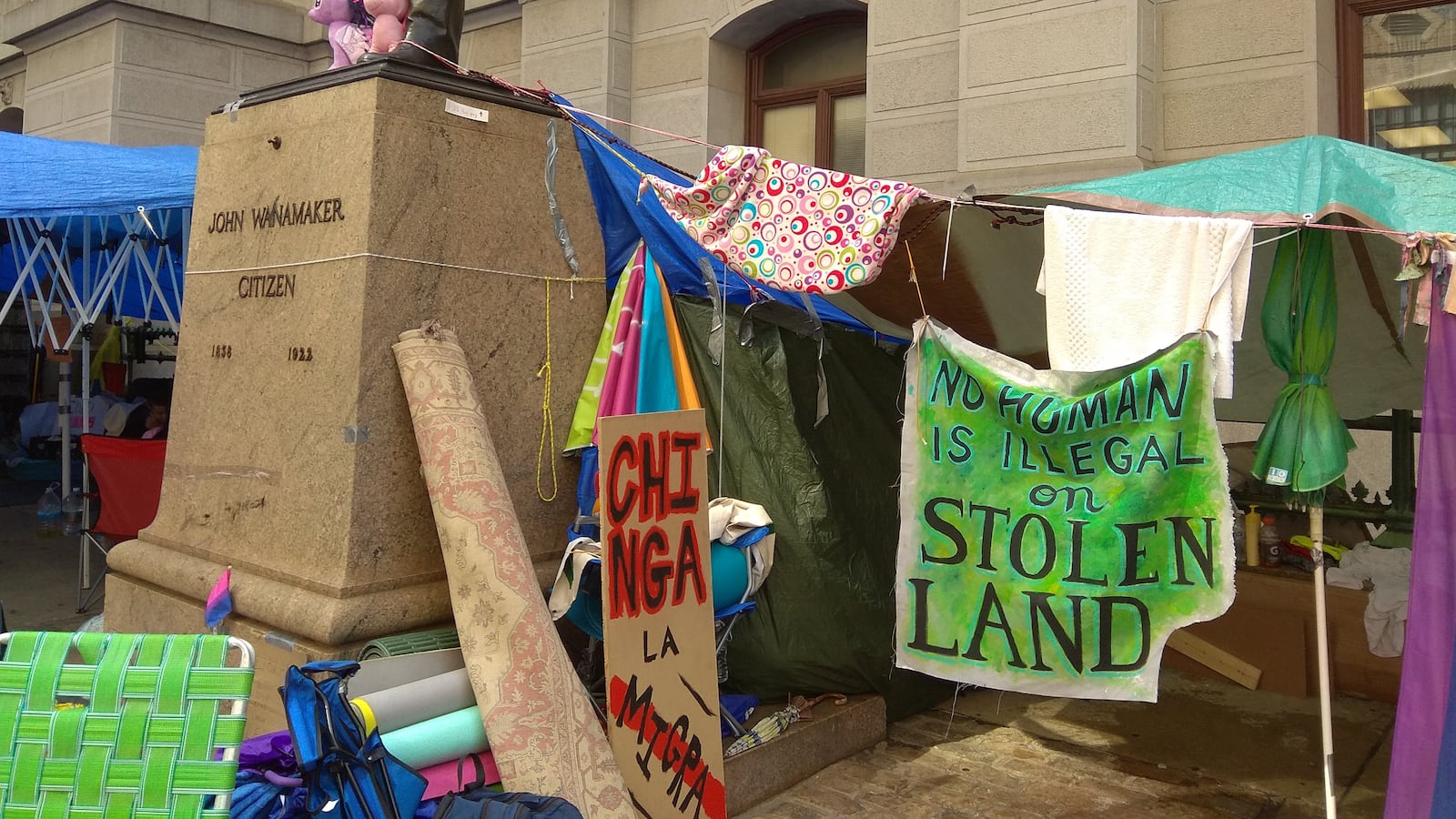This article was originally published in The Notebook. In August 2020, The Notebook became Chalkbeat Philadelphia.
On a sunny afternoon beneath the City Hall tower and its crowning statue of William Penn, the sound of traffic is occasionally interrupted by shouting about Immigration and Customs Enforcement and, in response, cars honking.
“End PARS now! Abolish ICE!”
The voice belongs to Michael Rice, who often stands beside Juniper Street, yelling at cars and passers-by over a bullhorn.
Rice, 60, is one of many people at the Occupy ICE camp outside City Hall. Nearly a month after protesters set up their first camp in Portland, Oregon, Occupy ICE has become a nationwide movement protesting immigration policies. The group in Philadelphia has three goals – abolish ICE, close the Berks Family Residential Center, where immigrants are detained, and stop the use of the city’s real-time arrest database (PARS) for information-sharing as part of a contract between ICE and the city government.

Mike Rice with his bullhorn at City Hall.
Despite the sweltering summer heat, protesters seemed to enjoy the convivial atmosphere.
“Here, everybody gets along. We have black people, brown people, white people, Puerto Ricans, Chinese, people from all nationalities, all races, and all different ages,” Rice said. “We all get along like one big happy family, which is what should be happening with the people in detention right now.”
Another protester, who wanted to be identified as deadbØy IX, echoed Rice’s assessment. “There’s definitely a pretty quiet and peaceful feeling here. It doesn’t feel like there’s a conflict,” he said.
It was not always this way, however. On July 3, police clashed with Occupy ICE protesters outside the ICE office at Eighth and Cherry Streets. Later that week, on July 5, police raided and demolished the protesters’ camp, forcing them to move to their current location at City Hall.
“At Eighth and Cherry, there was a constant police presence enforced by local police, Homeland Security, ICE agents, all of that. For a peaceful protest, it was totally unnecessary,” said Brian Gallagher, 31, a middle school teacher.
Gallagher has spent about 40 hours in total at both Occupy ICE camps and said that the City Hall camp has a smaller police presence.
“It’s not the same kind of [situation] – looking at a wall of police, feeling like any time they might decide to come in, destroy everything, and kick us out,” he said.
There was not much observable police activity at the City Hall camp on Friday, July 13. Several police officers cycled past in the morning and afternoon. A few others hung around different areas of City Hall, out of immediate sight of the camp.
Yet, the possibility of police retaliation may prevent others from showing up. “I have several friends who want to come, but feel too at-risk. Whether they are transgender people or people of color, they do not feel safe to protest, which is wrong,” deadbØy IX said.
He further emphasized how fear could be a powerful deterrent.
“You shouldn’t fear sticking up for your rights or the rights of others, but that’s the main thing that keeps people from coming to protests like this – it’s the fear of arrest, fear of injury, and fear of death,” he said.
Although the road ahead for Occupy ICE is not certain, Rice has plans to improve the camp. He plans to build a giant tarp over the entire camp to keep out the rain, with the statue of John Wanamaker as the centerpiece.
Rice also intends to build a wall out of milk crates and hang signs on it. “I’m going to take a picture of it and send it to Donald Trump,” he said.
Besides sprucing up the camp, protesters are hoping for more immediate action from the city government. At a press conference on July 12, Mayor Kenney and his administration said that they would meet with ICE officials during the upcoming week and come to a decision about the PARS contract as soon as possible.
deadbØy IX, however, believes that more can be done.
“The people that are talking about this, talking about PARS, and deciding what to do or not to do get to go home at night, go to their house, and see their family,” he said. “… The people who are waiting in the facilities, the children who are waiting for their parents – they don’t have that luxury. They don’t have a way of saying, ‘Oh, we’re going to talk about it next week,’” he said.
Gallagher said he sees the need to educate his students about the issues that Occupy ICE and other movements are focusing on, especially because he has less time to be present at City Hall once the school year begins.
“Whether it’s about immigration or the movements against police brutality, I think it’s important to expose the children to them,” he said.
“I’m not going to go in there and tell them exactly what I feel and have them agree with me, but to give them the texts, show them the videos, and give them the tools to make up their own mind about what they want to stand up for and what they don’t.”
Lijia Liu, a rising junior at Swarthmore College, is a Notebook intern this summer.


